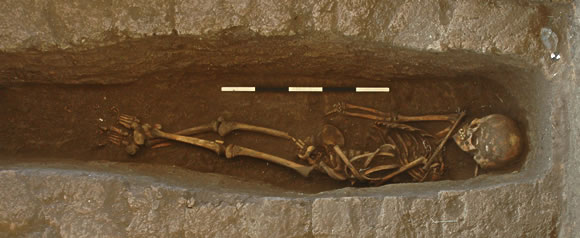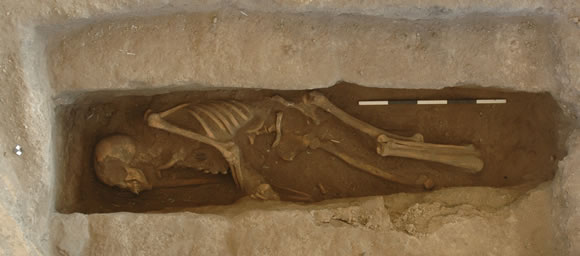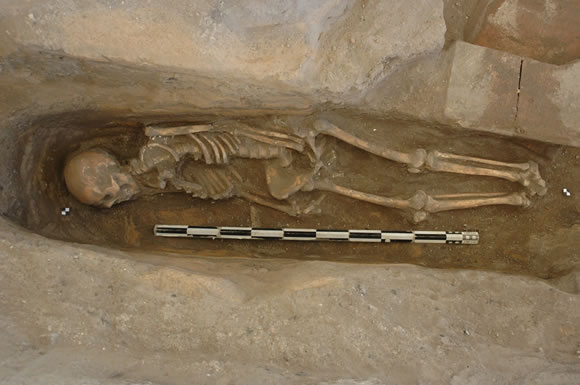ÇATALHÖYÜK 2005 ARCHIVE REPORT
| |
4040 Area Excavations
Area Supervisors: Doru Bogdan & Lisa Yeomans
Site Assistants: Ahmet Cinici, Tuna Kalayci, Esra Terzi Middle Eastern Technical University, Ankara), Candemir Zoruglu (Selcuk University) Konstantinos Koutsadelis (University of Cambridge), Elizabeth Lee (Univeristy of California, Berkeley), Stanford University Field School: Ulrike Krotscheck (supervisor), Cassandra Cueller, Shamala Gallagher, Amelia Strom Hardin, Bradley Heinz.
Authors: Doru Bodgan, Lisa Yeomans, Shahina Farid, Ulrike Krotscheck & Candemir Zoruglu
Classical and Later Activity
Klasik ve Geç Aktiviteler
Doru Bodgan, Lisa Yeomans, Shahina Farid
Abstract
Late activity in this year’s 10x40 strip consisted of part of the foundation trench of a probable Roman/Hellenistic building (Building 41, Spaces 212 and 216). This was located to the centre west of this year’s excavation in the 4040 Area. Surface scraping in 2003 when the destruction phase of the buildings, as well as some occupation layers were excavated first exposed this square structure. The foundation cut and fill, which cut through the Neolithic layers was not however excavated until this season. The foundations were made of clay, solidly packed in deep, wide trenches, suggesting the possibility of a multiple storey construction. The clay fill was clearly collected from the mound and it contained a quantity of Neolithic material.
A number of late burials were excavated stretching across the length of the10x40 strip. These appear to date from the Late Roman/Byzantine period displaying a typical position and orientation for this period. Most graves were simple rectangular cuts with single extended burials. The bodies were in an extended position with the heads to the west and the feet to the east. There was one exception to this pattern where the feet were to the west and the head to the east. Most of these skeletons were extended on their back but five individuals lay on their right side. These five individuals were clustered together in the southern sector. Four graves were clay lined, and three had evidence of coffins by the presence of iron nails and traces of decayed wood. One burial may have been disinterred and a further collection of human bone may have been a ‘clearance’ activity. Only two burials had associated grave goods. The different types of burial practices probably represent different phases and or cultural practices. The corpus of classical data from the site will be collated and reported on once it can be put into context with the off-site investigations currently being undertaken by a team from Selcuk University.
Özet
Bu sene kazılan 10x40 lık şeritteki geç aktivite, büyük ihtimalle Roma ya da Hellenistik bir binaya ait olan temel açmasının bir parçasından oluşmaktadır (Bina 41, Alan 212 ve 216). Bu şerit, 4040 alanında açılan bu seneki kazı alanının batısında bulunmaktadır. Bu kare şeklindeki yapı ilk olarak 2003 yılındaki yüzey kazıması sırasında bazı yerleşim tabakaları ve binaların yıkım evreleri kazılırken ortaya çıkarıldı. Ancak, Neolitik tabakaları kesen temel kesik ve dolgular bu sezona kadar kazılmadı. Kilden yapılmış olan temeller derin ve geniş açmalar şeklinde olup, birden fazla kattan oluşan bir yapının varlığını düşündürür. Kil dolgu höyükten toplanmış olup, Neolitik materyal içerir.
10x40lık şeridi boyunca kesen geç döneme ait bir çok sayıda gömü bulundu. Bu gömüler geç Roma ve Bizans dönemine ait bir pozisyon ve yönleme sergilediği için, aynı döneme tarihlenir. Bazı gömüler basit dikdörtgen kesikli ve tek uzantılıdır. İskeletler uzanmış bir vaziyette, başlar batıya ve ayaklar doğuya doğrudur. Bu düzene aykırı olan, ayakların batıya ve başın doğuya doğru uzandığı tek bir örnek vardır. Bu iskeletlerin çoğu sırt üstü uzanmış olup, beş tanesi sağ tarafları üzerine uzanmaktadırlar.Bu beş iskelet bir küme halinde güney kesiminde bulunmuşlardır. Dört gömü kil ile döşenmiş olup, bozulmuş ahşap ve demir çivi kalıntılarından dolayı üç tanesinde tabut bulunduğu düşünülmektedir. Bu gömülerden biri rahatsız edilmiş olduğu için ve bu yüzden bunu takip eden insan kemiği toplama aktivitesi bir temizleme aktivitesi olarak düşünülebilir. Sadece iki gömüde gömü hediyesi bulunmuştur. Farklı gömü aktiviteleri, büyük ihtimalle farklı evreleri ve kültürel aktiviteleri gösterir. Toplanan Klasik veriler, Selçuk Üniversitesi ekibi tarafından yapılan alan dışı araştırmalar ile birleştirilerek rapor edilecektir.
Introduction - Shahina Farid
During the Classical and Byzantine periods the Neolithic mound was used as a burial ground for the inhabitants of settlements located nearby. These settlements lie off-site in surrounding fields today and which are the focus of a team from Selcuk University who will locate, define and date the extents and types of sites present. There is also however, some late structural activity on the Neolithic mound which to date has been excavated largely at the southern crest of the mound in the TP Area (TP 2002 Archive Report), however the foundations of a large late structure was also defined in the 4040 Area. The following report describes the late sequence including the late burials from this year’s excavation. Although all the following burial descriptions post-date the Neolithic structures they have been referenced to the Neolithic building numbers for a purely locational exercise.
Building 41 - Doru Bogdan
Building 41 was first exposed in 2003 after the removal of the topsoil from the 4040 Area (Fig. 12). The almost completely defined building was identified by a series of wall foundations and associated wall collapse along the outer eastern edge. The demolished debris and some plaster floors were excavated and although a number of pottery sherds were recovered, the dating of the structure was not established. The foundations and associated construction cuts were numbered F.1213, F.1214, F.1217, F.1218, F.1219 and F.1220. The wall foundations collectively defined five internal spaces, Spaces 212, 215, 216, 217 and 225.
Excavation of Building 41 in 2005 was located along the western edge of the 10x40m strip so only its eastern end was in the sector excavated. By the end of the season the eastern wall foundation F.1213 was completely excavated, and the eastern sections of the east-west walls, F.1219 to the north, partition wall F.1220 and F.1217 to the south.
The wall foundations were very solid structures. Presumably for stability 1.1m wide trenches were dug with vertical edges to a depth varying between 0.8 and 1m. The trenches were then back-filled in two stages. Placed at the base of the construction cut was one course of very large mudbricks, while the upper part of the cut was filled with solid clay. The dimensions and the solidity of the foundations suggest that they were very likely to support a building that had more than one storey. The clay source for the mudbricks and for the upper part of the foundations was probably collected from pits cut into the mound as the fill contained large quantities of Neolithic material. The percentage of post-Neolithic finds within the excavated units was very small compared to the amount of Neolithic pottery, obsidian and bone retrieved from the foundation fill.
The dating of Building 41 remains uncertain since much of the upper levels of the building had eroded away. However the foundation truncated a grave (F.1598) (Fig. 14) containing a single sherd of Hellenistic pottery that gives a terminus post quem for Building 41.
Late Roman/Byzantine burials - Doru Bogdan and Lisa Yeomans
The grave F.1598 cut by the foundation trench for Building 41 contained the skeletal remains (10339) of a female laid with her head to the west. The upper torso and skull of the skeleton had been removed by the foundation cut (10279). It is should be noted that this skeleton appears to have been interred in a different manner to a number of skeletons excavated to the south which were buried in long, narrow and deep grave cuts with the bodies laid slightly on the right side (see below). Therefore different phases or cultural practices are represented amongst the late burials across the 4040 area and dating evidence from one grave is not applicable to the others.
In the same vicinity over the outline of Building 57 and cutting its east wall was a cut (12118), which was initially irregular in shape, but narrowed into a regular, rectangular grave cut (12119). It contained extended burial skeleton (12133).
Cutting the south wall of Building 57 an ovoid pit turned out to be an infant burial, F.2042. The burial cut double walls, the south wall of Building 57 and a possible retaining wall along the northern side of the midden area that bounded Building 57 to the south. The burial cut was clearly recognizable by colour and texture, although the top of the cut was not as clearly rectangular as the grave later proved to be. The skeleton was of an infant probably aged around two to three years lying on its right side, oriented along an east-west axis with its head to the west. Its knees were slightly flexed, and although the articulated bones were remarkably well-preserved, significant rodent activity had disturbed the burial enough that bones probably belonging to this skeleton were found in the adjacent Building 57 room fill (12116). Small amounts of wood were found in the grave fill. No notable grave goods were discovered in the associated grave fill. The grave additionally cut through F. 2110, the south oven in Building 57 (see below) (Amelia Strom Hardin).
To the east over the footprint of Building 54, F.2155 was a grave dug through the internal wall F.2138 dividing Spaces 265 and 266. The skeleton (11951) was that of a supine extended adult with the head to the west, and probably interred in a wooden coffin indicated by iron nails found around the bones but no wood traces survived. The probable coffin was placed in a narrow cut with vertical edges and flat base. No grave goods were found.
F.2157 was the grave of an infant, placed in a small cut, located in the southwestern corner outline of Space 265. The skeleton (11986) was found dorsally extended, with the head to the west, in a good state of preservation. No traces of coffin and no grave goods were present.
South of Building 57 cutting through the midden deposits of Space 275 a large irregular shaped cut proved to be two intercutting graves. Burial F.2188 with an adult female skeleton (12141) lying on her right side in an extended position within a simple cut and F.2189 was a heavily truncated adolescent (12142).
In the southern-most sector of this years 10x40m strip Space 273, located to the south of midden area 275, was identified in 2003 as a Neolithic house with typical mudbrick walls defining it on three sides while its southern wall lies beyond the scraped area. In the last four days of this year’s excavation season, the decision was made for at least some of the room fill to be removed in order to expose the walls and better understand their layout. After further surface clearing a number of east-west burials was observed within the area delineated by the north-south extent of Space 273 and the width of the excavation trench, as well as two irregular interments.
The first discovered skeleton (12366) was very close to the surface and therefore severely affected by erosion. The grave cut was ill-defined and the fill covering the body was very similar to the soil into which the cut was dug. Despite the east-west orientation of the grave, this late burial (F.2161) is rather unusual due to the fact that the head was placed at the eastern end of the cut. Several greenish beads, circular and tubular, were found in the neck region of the skeleton.

Figure 15. Skeleton (12384) in F. 2162 was a child of approximately 6-8 years old. |
The second atypical interment F.2160 consists of parts of three skeletons ((12359), (12360), (12385)) found in a secondary burial context. The bones were co-mingled, the long bones being concentrated together as were the crania, only few of them appearing to be in roughly articulated position. All evidence suggested that the skeletons were disturbed from their initial position and re-buried. It is possible that the remains were placed in a shallow cut (very difficult to identify during excavation being so close to the surface and therefore disturbance), or the remains were part of a ‘clearance’ dump alongside roman tegulae and mortar that was also found in the fill. This large unit was not fully excavated by the end of the season, but it seems to post-date one of the east-west graves of possible Christian rite.
Along the west wall of Space 273, cutting through it, a row of four graves was identified presenting obvious similarities as well as some particularities. All four were east-west oriented, but only three of them (F.2162, F.2170 and F.2187) were lined with very solid, carefully prepared clay, while the fourth (F.2169) was a simple skeleton placed in the cut. The skeletons were laid all in the same position, with the head to west dorsally extended, slightly on the right side and similar to other burials in the vicinity. Only three of the four graves (F.2162, F.2170 and F.2169) contained skeletons, while F.2187 was empty.
F.2162 and F.2170 are identical side-by-side graves, with skeletons placed on their right side placed in rectangular cuts with sides lined with thick clay. There were no grave goods nor traces of wood coffins as have been found elsewhere. Skeleton (12386) in F.2170 was that of an adult male. The lower legs had been subsequently disturbed and moved towards the torso. Skeleton (12384) in F.2162 was an approximately six-eight year old child. The similarity of these two burials along with their proximity suggests a short time span between the two interments.

Figure 16. Skeleton (12386) in F.2170 was an adult male; the lower legs had been subsequently disturbed. |
Skeleton (12381) in burial F.2169 was that of an adult which was placed slightly on the right side in a clay lined oval cut unlike the rectangular cuts immediately south from it. The cut (12382) for (12381) clearly truncates the southwestern corner of another burial F.2187 and is therefore later. F.2187 is the largest grave cut of the four but lacking a skeleton. Rectangular in shape, with vertical sides substantially lined with clay and a tegulae on the base, which is probably Roman/Byzantine in date. Only one tile was still in situ on the base while fragments of the others were spread within the fill. This indicates that the entire feature was disturbed and backfilled and possibly explains the absence of a skeleton. However, there is a possibility that the grave was a cenotaph, which allowed a burial ceremony to take place for an individual whose corpse could not be interred. The east-west orientation and the presence of Roman/Byzantine artifacts within them strongly suggest that all these graves were of Christian rite.

Figure 17. Skeleton (12381) in burial F.2169. |
As well as the burials located within the footprint of Space 273 there was one other feature. This was a very deep cut (12354), oval in shape that cut through the northwestern corner of Burial F.2187 at a sharp angle. Fragments of Roman/Byzantine tiles were placed on the sides, while on the bottom traces of possible postholes were observed. The dimensions and shape of the cut suggest it was a constructional feature and its proximity to the foundations of Building 41 suggests a hoist or scaffold emplacement during the construction of Building 41. There was no stratigraphical relationship to support such an interpretation but true it would date Building 41 as later than grave F.2187 which is most likely Late Roman/Byzantine.
Two late burials were excavated in the northern most sector of this year’s excavations. Towards the east of the midden area Space 271, was a late burial F.2120 containing the skeleton of a juvenile (12336) lying extended with the head to the west. A glass vial had been placed next to the right side of the head and a single coffin nail was recovered from the fill. A little to the north, over the footprint of Space 254, cutting through the infill (10312) was a grave cut (10315) was for a late grave F.1571 containing the skeleton (10314) of an adult male lying in the extended position with the head to the west buried in a coffin. The grave truncated the southern side of a pit (10328) containing an ashy fill (10327) and although this as relatively sterile it was probably a late pit.
| |
© Çatalhöyük Research Project and individual authors, 2005